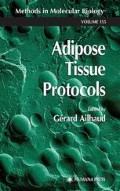Abstract
Glucose enters the cell by a carrier-mediated, facilitated diffusion mechanism, which, in most tissues, exhibits no energy or counter-ion requirements. In adipose tissues and skeletal muscle, glucose entry is acutely regulated by insulin and other hormones (1,2). Indeed, in those tissues, glucose transporter 4 (GLUT4) is the chief isoform which is, in basal conditions, retained in a specific intracellular storage compartment (3). The GLUT4-containing vesicles are translocated to the plasma membrane in response to insulin, thus allowing for the massive entry of glucose into the cells (1,2). Adipocytes also contain a small proportion of the ubiquituously expressed glucose transporter, GLUT1, which is at a similar level at the plasma membranes and inside the cell (3). Because of this basal distribution, insulin effect on GLUT1 translocation is minor.
Access this chapter
Tax calculation will be finalised at checkout
Purchases are for personal use only
References
Rea, S. and James, D. E. (1997) Moving GLUT4. The biogenesis and trafficking of GLUT4 storage vesicles. Diabetes 46, 1667–1677.
Simpson, I. A. and Cushman, S. W. (1986) Hormonal regulation of mammalian glucose transport. Annu. Rev. Biochem. 55, 1059–1089.
Gould, G. W. and Holman, G. D. (1993) The glucose transporter family: structure, function and tissue-specific expression. Biochem. J. 295, 329–341.
Rodbell, M. (1968) Metabolism of hormones on glucose metabolim and lipolysis. J. Biol. Chem. 239, 375–380.
Olefsky, J. M. (1975) Effects of dexamethasone on insulin binding, glucose transport and glucose oxidation of isolated rat adipocytes. J. Clin. Invest. 56, 1499–1508.
Livingston, J. N. and Lockwood, D. H. (1975) Effect of glucocorticoids on the glucose transport system of isolated fat cells. J. Biol. Chem. 250, 8353–8360.
Vinten, J., Gliemann, J., and Østerlind, K. (1975) Exchange of 3-O-methylglucose in isolated fat cells. J. Biol. Chem. 251, 794–800.
Moody, A. J., Stan, M. A., and Stan, M. (1974) A simple free fat cell bioassay for insulin. Horm. Metabol. Res. 6, 12–16.
Kashiwagi, A., Verso, M. A., Andrews, J., Vasquez, B., Reaven, G., and Foley, J. E. (1983) In vitro insulin resistance of human adipocytes isolated from subjects with noninsulin-dependent diabetes mellitus. J. Clin. Invest. 72, 1246–1254.
Quon, M. J., Butte, A. J., Zarnowski, M. J., Sesti, G., Cushman, S. W., and Taylor, S. I. (1994) Insulin receptor substrate 1 mediates the stimulatory effect of insulin on GLUT4 translocation in transfected rat adipose cells. J. Biol. Chem. 269, 27,920–27,924.
Tanti, J.-F., Grémeaux, T., Grillo, S., Calleja, V., Klippel, A., Williams, L. T., Van Obberghen, E., and Le Marchand-Brustel, Y. (1996) Overexpression of a constitutively active form of phosphatidylinositol 3-kinase is sufficient to promote Glut 4 translocation in adipocytes. J. Biol. Chem. 271, 25,227–25,232.
Robinson, L. J., Pang, S., Harris, D. S., Heuser, J., and James, D. E. (1992) Translocation of the glucose transporter (GLUT4) to the cell surface in permeabilized 3T3-L1 adipocytes: Effects of ATP, insulin, and GTPγS and localization of GLUT4 to clathrin lattices. J. Cell Biol. 117, 1181–1196.
Laemmli, U. K. (1970) Cleavage of structural proteins during the assembly of the head of bacteriophage T4. Nature 227, 680–685.
Cormont, M., Bortoluzzi, M.-N., Gautier, N., Mari, M., Van Obberghen, E., and Le Marchand-Brustel, Y. (1996) Potential role of Rab4 in the regulation of subcellular localization of Glut4 in adipocytes. Mol. Cell. Biol. 16, 6879–6886.
Quon, M. J., Zarnowski, M., Guerre-Millo, M., De La Luz Sierra, M., Taylor, S. I., and Cushman, S. W. (1993) Transfection of DNA into isolated rat adipose cells by electroporation. Evaluation of promoter activity in transfected adipose cells which are highly responsive to insulin after one day in culture. Biochem. Biophys. Res. Commun. 194, 338–346.
Tanti, J.-F., Grillo, S., Grémeaux, T., Coffer, P. J., Van Obberghen, E., and Le Marchand-Brustel, Y. (1997) Potential role of protein kinase B in glucose transporter 4 translocation in adipocytes. Endocrinology 138, 2005–2010.
Smith, F. S. and Titheradge, M. A. (1998) Detection of NOS isoforms by Western-Blot analysis, in Methods in Molecular Biology, Vol 100. Nitric Oxide Protocols (Tithradge, M. A., eds.), Humana, Totowa, NJ, pp. 171–180.
Author information
Authors and Affiliations
Editor information
Editors and Affiliations
Rights and permissions
Copyright information
© 2001 Humana Press Inc.
About this protocol
Cite this protocol
Tanti, JF., Cormont, M., Grémeaux, T., Le Marchand-Brustel, Y. (2001). Assays of Glucose Entry, Glucose Transporter Amount, and Translocation. In: Ailhaud, G. (eds) Adipose Tissue Protocols. Methods in Molecular Biology™, vol 155. Springer, Totowa, NJ. https://doi.org/10.1385/1-59259-231-7:157
Download citation
DOI: https://doi.org/10.1385/1-59259-231-7:157
Publisher Name: Springer, Totowa, NJ
Print ISBN: 978-0-89603-747-2
Online ISBN: 978-1-59259-231-9
eBook Packages: Springer Protocols

